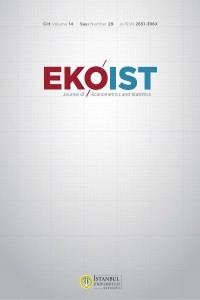İKTİSAT FAKÜLTESİ ÖĞRENCİLERİNDE İNTERNET BAĞIMLILIĞI TESTİ
Çalışmada iktisat fakültesi öğrencilerinde internet bağımlılığının ve internet bağımlılığı ile öğrencilerin sosyodemografik özellikleri arasındaki ilişkinin araştırılmıştır. Bu kapsamda İstanbul Üniversitesi’nde öğrenim görmekte olan 673 öğrenci ile anket çalışması yapılmıştır. Elde edilen verilere Açıklayıcı Faktör Analizi (AFA) ve hipotez testleri uygulanmıştır. Katılımcıların %3’ünün internet bağımlısı olduğu tespit edilmiş olup, öğrencilerin yaşadığı yerin, ekonomik düzeyinin, gazete ve kitap okuma alışkanlığının, internet bağımlılığı üzerinde etkili olduğu sonucuna ulaşılmıştır.
Anahtar Kelimeler:
İnternet Bağımlılığı, Faktör Analizi, Üniversite Öğrencileri
INTERNET ADDICTION TEST IN FACULTY OF ECONOMIC STUDENTS
In the study, the relationship between internet addiction and internet addiction in students of economics faculty and the sociodemographic characteristics of students were researched. Within this scope, a survey study was conducted with 673 students studying at Istanbul University. Descriptive Factor Analysis (AFA) and hypothesis tests were applied to the obtained data. 3% of the participants were found to be addicted to the Internet and it was found that the place where the students live, the economic level, the habit of reading newspapers and books were influential on internet addiction.
Keywords:
Internet Addiction, Factor Analysis, University Students,
___
- Balcı, Ş., & Gülnar, B. (2009). Üniversite Öğrencileri Arasında İnternet Bağımlılığı ve İnternet Bağımlılarının Profili. Selçuk Üniversitesi İletişim Fakültesi Akademik Dergisi, 6(1), 5–22.
- Balta, Ö. Ç., & Horzum, M. B. (2008). İnternet Bağımlılığı Testi. Journal of Educational Sciences & Practices, 7(13).
- Banjanin, N., Banjanin, N., Dimitrijevic, I., & Pantic, I. (2015). Relationship between internet use and depression: focus on physiological mood oscillations, social networking and online addictive behavior. Computers in Human Behavior, 43, 308–312
- Beard, K. W. (2005). Internet addiction: a review of current assessment techniques and potential assessment questions. CyberPsychology & Behavior, 8(1), 7–14.
- Beard, K. W. (2011). Working with adolescents addicted to the Internet. Internet addiction: A handbook and guide to evaluation and treatment.
- Beard, K. W., & Wolf, E. M. (2001). Modification in the proposed diagnostic criteria for Internet addiction. CyberPsychology & Behavior, 4(3), 377–383.
- Bektaş, H. (2017). Açıklayıcı Faktör Analizi. İstanbul: Beta Yayınevi.
- Caplan, S. E. (2002). Problematic Internet use and psychosocial well-being: Development of a theory-based cognitive-behavioral measurement instrument. Computers in Human Behavior, 18(5), 553–575.
- Davis, R. A. (2001). A cognitive-behavioral model of pathological Internet use. Computers in Human Behavior, 17(2), 187–195.
- Ergin, A., Uzun, S. U., & Bozkurt, A. İ. (2013). Tıp fakültesi öğrencilerinde internet bağımlılığı sıklığı ve etkileyen etmenler Internet addiction prevalence and contributing factors in the medical faculty students. Pamukkale Tıp Dergisi, 6(3), 134–142.
- Eşği, N. (2014). Aile-Çocuk İnternet Bağımlılık Ölçeğinin Türkçeye Uyarlanması: Geçerlik Ve Güvenirlik Çalışması. Kastamonu Eğitim Dergisi, 22(2), 807–839.
- George, D. (2011). SPSS for windows step by step: A simple study guide and reference, 17.0 update, 10/e. Pearson Education India.
- Kandell, J. J. (1998). Internet addiction on campus: The vulnerability of college students. CyberPsychology & Behavior, 1(1), 11–17.
- Kuss, D. J., Griffiths, M. D., & Binder, J. F. (2013). Internet addiction in students: Prevalence and risk factors. Computers in Human Behavior, 29(3), 959–966.
- Kutlu, M., Savcı, M., Demir, Y., & Aysan, F. (2016). Young İnternet Bağımlılığı Testi Kısa Formunun Türkçe Uyarlaması: Üniversite Öğrencileri Ve Ergenlerde Geçerlilik Ve Güvenilirlik Çalışması. Anatolian Journal of Psychiatry/Anadolu Psikiyatri Dergisi, 17.
- Pawlikowski, M., Altstötter-Gleich, C., & Brand, M. (2013). Validation and psychometric properties of a short version of Young’s Internet Addiction Test. Computers in Human Behavior, 29(3), 1212–1223.
- Pui, S., Law, M., & Chang, K. (2007). Factor Structure for the Internet Addiction Test: A Confirmatory Approach. International DSI / Asia and Pacific DSI , 1–12.
- Raykov, T., & Marcoulides, G. A. (2008). Principal component analysis. An Introduction to Applied Multivariate Analysis. Lawrence Erlbaum Associates, Inc. Publishers. Routledge, EUA.
- Rupp, A., Koh, K., & rupp, B. D. (2003). What is the impact on exploratory factor analysis results of a polychoric correlation matrix from LISREL/PRELIS and EQS when some respondents are not able to follow the rating scale. In annual meeting of the American Educational Research Association (AERA) in Chicago, Illinois.
- Şahin, C., & Korkmaz, Ö. (2011). İnternet Bağımlılığı Ölçeğinin Türkçeye Uyarlanması. Selçuk Üniversitesi Ahmet Keleşoğlu Eğitim Fakültesi Dergisi, 32, 101–115.
- Tabachnick, B. G., & Fidell, L. S. (2013). Using Multivariate Statistics (Sixth). Boston.
- Thompson, S. (1996). Internet connectivity: addiction and dependency study. Unpublished Honors Thesis, Pennsylvania State University, State College, PA)[On-Line].
- Young, K. S. (1996). Psychology of computer use: XL. Addictive use of the Internet: A case that breaks the stereotype. Psychological Reports, 79(3 Pt 1), 899–902.
- Young, K. S. (1998). Caught in the net: How to recognize the signs of internet addiction--and a winning strategy for recovery. John Wiley & Sons.
- Young, K. S. (1998). Internet Addiction : The Emergence of a New Clinical Disorder. Cyber Psychology & Behavior, 1(3), 237–244.
- Young, K. S. (2004). Internet Addiction: A New Clinical Phenomenon and Its Consequences. American Behavioral Scientist, 48(4), 402–415.
- Zumbo, B. D., Gadermann, A. M., & Zeisser, C. (2007). Ordinal versions of coefficients alpha and theta for Likert rating scales. Journal of Modern Applied Statistical Methods, 6(1), 4.
- Zumbo, B. D., & Rupp, A. A. (2004). Responsible modeling of measurement data for appropriate inferences. The SAGE Handbook of Quantitative Methodology for the Social Sciences, 73.
- Yayın Aralığı: Yılda 2 Sayı
- Yayıncı: İstanbul Üniversitesi
